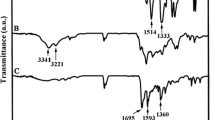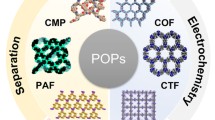Abstract
Two new ionic porous organic polymers (iPOPs) with different counter anions were successfully fabricated via well-known pyrylium mediated transformation into pyridinium. 13C solid-state NMR, XPS, and FTIR were analyzed and confirmed the formation of pyridinium in the network. Containing charged and aromatic networks, both iPOPs exhibit a high affinity towards toxic hexavalent chromium Cr(VI) ions. What is more, it has been demonstrated that both CO2 adsorption and Cr(VI) removal properties can be tuned by simply varying counter anions.
Similar content being viewed by others
References
Li, H.; Li, J. H.; Thomas, A.; Liao, Y. Ultra-high surface area nitrogen-doped carbon aerogels derived from a Schiff-base porous organic polymer aerogel for CO2 storage and supercapacitors. Adv. Funct. Mater.2019, 29, 1904785.
Shen, R.; Zhu, W.; Yan, X. G.; Li, T.; Liu, Y.; Li, Y. X.; Dai, S. Y.; Gu, Z. G. A porphyrin porous organic polymer with bicatalytic sites for highly efficient one-pot tandem catalysis. Chem. Commun.2019, 55, 822–825.
Krishnan, S.; Suneesh, C. V. Fluorene-triazine conjugated porous organic polymer framework for superamplified sensing of nitroaromatic explosives. J. Photoch. Photobio. A2019, 371, 414–422.
Weeraratne, K. S.; Alzharani, A. A.; El-Kaderi, H. M. Redox-active porous organic polymers as novel electrode materials for green rechargeable sodium-ion batteries. ACS Appl. Mater. Interfaces2019, 11, 23520–23526.
Zhang, W. J.; Aguila, B.; Ma, S. Q. Potential applications of functional porous organic polymer materials. J. Mater. Chem. A2017, 5, 8795–8824.
Gu, C.; Huang, N.; Chen, Y. C.; Qin, L. Q.; Xu, H.; Zhang, S. T.; Li, F. H.; Ma, Y. G.; Jiang, D. L. π-Conjugated microporous polymer films: designed synthesis, conducting properties, and photoenergy conversions. Angew. Chem. Int. Ed.2015, 54, 13594–13598.
Li, Z. P.; Li, H.; Xia, H.; Mu, Y. Triarylboron-linked conjugated microporous polymers: sensing and removal of fluoride ions. Chem. Eur. J.2015, 21, 17355–17362.
Buyukcakir, O.; Je, S. H.; Talapaneni, S. N.; Kim, D.; Coskun, A. Charged covalent triazine frameworks for CO2 capture and conversion. ACS Appl. Mater. Interfaces2017, 9, 7209–7216.
Chen, G.; Huang, X.; Zhang, Y.; Sun, M.; Shen, J.; Huang, R.; Tong, M.; Long, Z.; Wang, X. Constructing POSS and viologen-linked porous cationic frameworks induced by the Zincke reaction for efficient CO2 capture and conversion. Chem. Commun.2018, 54, 12174–12177.
Gang, X.; Bin, W. B.; Xin, Y. L.; Yi, R. B.; Ke, H. Y.; Fu, D.; Ileana, D.; Valerian, D.; Guang, S. Y. Hypervalent silicon-based, anionic porous organic polymers with solid microsphere or hollow nanotube morphologies and exceptional capacity for selective adsorption of cationic dyes. J. Mater. Chem. A2019, 3, 393–404.
Das, G.; Skorjanc, T.; Sharma, S. K.; Gandara, F.; Lusi, M.; Shankar Rao, D. S.; Vimala, S.; Krishna Prasad, S.; Raya, J.; Han, D. S.; Jagannathan, R.; Olsen, J. C.; Trabolsi, A. Violgenn-aasdd conjugated covalent organic networks via Zincke reaction. J. Am. Chem. Soc.2017, 139, 9558–9565.
Shen, X. C.; Ma, S.; Xia, H.; Shi, Z.; Mua, Y.; Liu, X. M. Cattonic porous organic polymers as an excellent platform for highly efficient removal of pollutants from water. J. Mater. Chem. A2018, 6, 20653–20658.
Liu, T. T.; Liang, J.; Huang, Y. B.; Cao, R. A bifunctional cationic porous organic polymer based on a Salen-(Al) metalloligand for the cycloaddition of carbon dioxide to produce cyclic carbonates. Chem. Commun.2016, 52, 13288–13291.
Dong, D.; Zhang, H.; Zhou, B.; Sun, Y. F.; Zhang, H. L.; Cao, M.; Li, J. B.; Zhou, H.; Qian, H.; Lin, Z. Y.; Chen, H. G. Porous covalent organic frameworks for high transference number polymer-based electrolytes. Chem. Commun.2019, 55, 1458–1461.
Huang, N.; Wang, P.; Addicoat, M. A.; Heine, T.; Jiang, D. Ionic covalent organic frameworks: design of a charged interface aligned on 1D channel walls and its unusual electrostatic functions. Angew. Chem. Int. Ed.2017, 56, 4982–4986.
Zhao, Y. S.; Li, S. Q.; Zheng, X. S.; Tang, J. B.; She, Z. J.; Gao, G.; You, J. S. Rh/Cu-catalyzed cascade[4+2] vinylic C-H o-annulation and ring contraction of a-aryle enones with alkynes in air. Anqewi. Chem. Int. Ed.2017, 56, 4286–4289.
Garciá-Acosta, B.; Comes, M.; Bricks, J. L.; Kudinova, M. A.; Kurdyukov, V. V.; Tolmachev, A. I. Sensory hybrid host materials for the selective chromo-fluorogenic detection of biogenic amines. Chem. Commun.2006, 21, 2239–2241.
Martinez-Hayaa, R.; Bareckaa, M. H.; Miroa, P.; Marina, M. L.; Miranda, M. A. Photocatalytic treatment of cork wastewater pollutants. Degradation of gallic acid and trichloroanisole using triphenyl(thia)pyrylium salts. Appl. Catal. B2015, 179, 433–438.
Katritzky, A. R.; Marson, C. M. Pyrylium mediated transformations of primary amino groups into other functional groups. Angew. Chem. Int. Ed.1984, 23, 420–429.
Katritzky, L. R.; Manzo, R. H.; Lloyd, J. M.; Patel, R. C. Mechanism of the pyrylium/pyridinium ring interconversion. Mild preparative conditions for conversion of amines into pyridinium ions. Angew. Chem. Int. Ed.1980, 92, 315–316.
Wang, H.; Qian, X. M.; Wang, K.; Su, M.; Haoyang, W. W.; Jiang, X.; Brzozowski, R.; Wang, M.; Gao, X.; Li, Y. M.; Xu, B. Q.; Eswara, P.; Hao, X. Q.; Gong, W. T.; Hou, J. L.; Cai, J. F.; Li, X. P. Supramolecular Kandinsky circles with high antibacterial activity. Nat. Commun. 2018, 9, 1815–1824.
Qian, X. M.; Gong, W. T.; Wang, F. R.; Lin, Y.; Ning, G. L. A pyrylium-based colorimetric and fluorimetric chemosensor for the selective detection of lysine in aqueous environment and real sample. Tetrahedron Lett.2015, 56, 2764–2767.
Gong, W. T.; Zhang, Q. L.; Wang, F. R.; Gao, B.; Lin, Y.; Ning, G. L. Selective sensing of H2PO4− (Pi) driven by the assembly of anthryl pyridinium ligands. Org. Biomol. Chem.2012, 10, 7578–7583.
Qian, X. M.; Gong, W. T.; Li, X. P. Fluorescent cross-linked supramolecular polymer constructed by orthogonal self-assembly of metal-ligand coordination and host-guest interaction. Chem. Eur J.2016, 22, 6881–6890.
Qian, X. M.; Gong, W. T.; Dhinakaran, M. K. Two bent-shaped π-organogelators: synthesis, fluorescence, self-assembly and detection of volatile acid vapours in gel films and in gel-gel states. Soft Matter2015, 11, 9179–9187.
Gong, W. T.; Qian, X. M.; Wang, F. R. Synthesis and photophysical properties of new highly conjugated bispyrylium compounds. Heteroatom Chem.2013, 24, 66–71.
Harris, F. W.; Chuang, K. C.; Huang, S. X.; Janimak, J. J.; Cheng, S. Z. D. Aromatic poly(pyridinium salt)s: synthesis and structure of organo-soluble, rigid-rod poly(pyridinium tetrafluoroborate)s. Polymer1994, 35, 4940–4948.
Bhowmik, P. K.; Burchett, R. A.; Han, H.; Cebe, J. J. Synthesis and characterization of poly(pyridinium salt)s with organic counterion exhibiting both lyotropic liquid-crystalline and light-emitting properties. Macromolecules2001, 34, 7579–7581.
Gomes, R.; Bhanja, P.; Bhaumik, A. A triazine-based covalent organic polymer for efficient CO2 adsorption. Chem. Commun. 2015, 51, 10050–10053.
Che, S. Y.; Yang, Z. Z.; Popovs, I.; Luo, H. M.; Luo, Y. L.; Guo, W.; Chen, H.; Wang, T.; Jie, K. C.; Wang, C. M.; Dai, S. A succinct strategy for construction of nanoporous ionic organic networks from a pyrylium intermediate. Chem. Commun.0019, 55, 13450–13453.
Pietrzak, R. XPS study and physico-chemical properties of nitrogen-enriched microporous activated carbon from high volatile bituminous coal. Fuel2009, 88, 1871–1877.
Wang, Y.; Tao, J.; Xiong, S. H.; Lu, P.; Tang, J. T.; He, J. Q.; Javaid, M. U.; Pan, C. Y.; Yu, G. P. Ferrocene-based porous organic polymers for high-affinity iodine capture. Chem. Eng. J.2020, 380, 122420–122425.
Li, X. M.; Zhou, M. J.; Jia, J. X.; Jia, Q. A water-insoluble viologen-based β-cyclodextrin polymer for selective adsorption toward anionic dyes. React. Funct. Polym.2018, 126, 20–26.
Su, Y. Q.; Wang, Y. X.; Li, X. J.; Li, X. X.; Wang, R. H. Imidazolium-based porous organic polymers: anion exchange driven capture and luminescent probe of Cr2O72−. ACS Appl. Mater. Interfaces2016, 8, 18904–18911.
Wen, T.; Fan, Q. H.; Tan, X. L.; Chen, Y. T.; Chen, C. L.; Xu, A. W.; Wang, X. K. A core-shell structure of polyaniline coated protonic titanate nanobelt composites for both Cr(VI) and humic acid removal. Polym. Chem.2016, 7, 785–794.
Zhang, C. H.; Liu, Y. C.; Sun, L. B.; Shi, H. Z.; Shi, C.; Liang, Z. Q.; Li, J. Y. A zwitterionic ligand-based cationic metal-organic famework for rapidly selective dye capture and highly efficient Cr2O72− removal. Chem. Eur J.2018, 24, 2718–2724.
Guo, D. M.; Ana, Q. D.; Xiao, Z. Y.; Zhai, S. R. Efficient removal of Pb(II), Cr(VI) and organic dyes by polydopamine modified chitosan aerogels. Carbohyd Polym.2018, 202, 306–314.
Liang, X. T.; Fan, X. Y.; Li, R. M.; Li, S. R.; Shen, S. K.; Hu, D. D. Efficient removal of Cr(VI) from water by quaternized chitin/branched polyethylenimine biosorbent with hierarchical pore structure. Bioresource Technol.2018, 250, 178–184.
Song, L.; Liu, F. Q.; Zhua, C. Q.; Li, A. M. Facile one-step fabrication of carboxymethyl cellulose based hydrogel for highly efficient removal of Cr(VI) under mild acidic condition. Chem. Eng. J.2019, 369, 641–651.
Zhang, L.; Niu, W.; Sun, J.; Zhou, Q. Efficient removal of Cr(VI) from water by the uniform fiber ball loaded with polypyrrole: static adsorption, dynamic adsorption and mechanism studies. Chemosphere2020, 248, 126102–126112.
Acknowledgments
This work was financially supported by the National Natural Science Foundation of China (No. 21206016 for W.T. Gong, No. U1808210 for G.L. Ning), the Fundamental Research Funds for the Central Universities (No. DUT-17LK07), and the Natural Science Foundation of Liaoning province (No. 2019-MS-046).
Author information
Authors and Affiliations
Corresponding authors
Electronic Supplementary Information
Rights and permissions
About this article
Cite this article
Zhang, SY., Gong, WT., Qu, WD. et al. Construction of Ionic Porous Organic Polymers (iPOPs) via Pyrylium Mediated Transformation. Chin J Polym Sci 38, 958–964 (2020). https://doi.org/10.1007/s10118-020-2436-4
Received:
Accepted:
Published:
Issue Date:
DOI: https://doi.org/10.1007/s10118-020-2436-4




